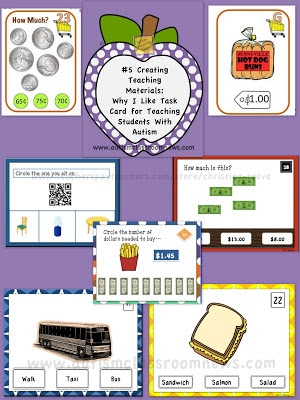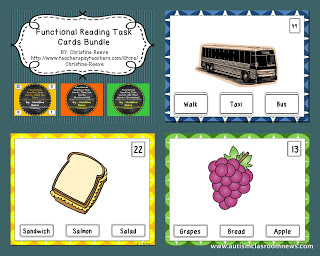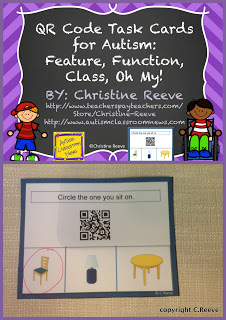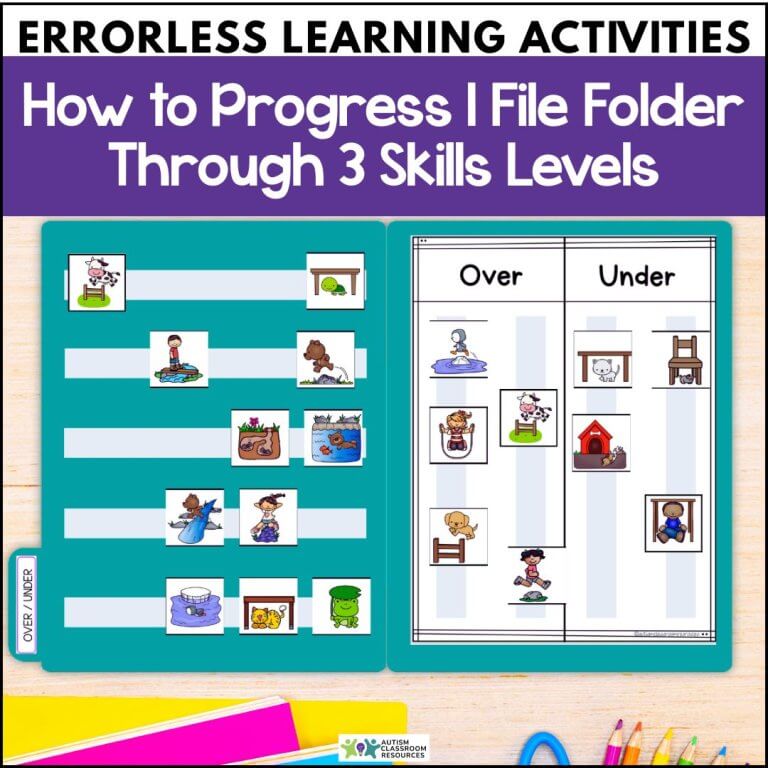If you are familiar with my Teachers Pay Teachers store, you will notice that I am partial to task cards. I think that task cards can help to address a number of the issues that students with autism have in learning and are a very versatile and adaptable tool for practicing skills in the classroom. I’m going to share some task cards I’ve created but also talk about what I look for in task cards and some resources for finding and using them in your classroom.
What Are Task Cards?
Honestly before I got involved with TPT I didn’t know what they were either. They are actually a tool that is used frequently with typical learners and I think their popularity has really increased as teachers have been reaching for tools to differentiate their instruction across their classrooms. Simply put, a task card is a card that has a task the student is supposed to complete on it. They come in a range of sizes and types from short passages printed on the card with a comprehension question the student has to answer, to multiple choice task cards for naming items or money amounts. The multiple choice ones tend to be the ones I’ve made most frequently for students with autism as it eliminates the need for an answer sheet. Answer sheets are sometimes more than students can manage during work (too many pieces of paper, shifting attention back and forth, etc.). Task cards are designed to be practice tools, not teaching tools necessarily, and are great for students who finish first, for centers, and for independent work. Rachel Lynette has a great free e-book at TPT about task cards and blogs about them at Totally Task Cards with a great explanation of the different types. Teaching with a Mountain View also blogs about task cards at Task Cards Corner. Both sites have freebies and good examples of both cards and ways to store and use them.
Why Task Cards for Autism?
As you can see from the picture above, I have created a number of different types of task cards for different skills. The things they have in common are that all allow the student to answer on the card itself. I do this because most of the students I work with in special education would have difficulty with cards that required them to transfer their answers to an answer sheet. Typically I provide answer sheets (and keys) if you have students who can use them, but I like students to have the option of answering right on the card. It makes it more direct. I can do this, thus far at least, because most of the skills I’ve addressed in task cards have been functional, concrete skills like matching words to pictures, rather than more abstract skills like inferences that you might see in a typical classroom. So with these cards, here are the reasons I have adopted them for students on the spectrum.
1. Differentiation for Amount
It’s easy to accommodate for learners who work at different speeds and for students who are easily overwhelmed. Based on the learner, you can give 2 cards or 20. It’s also easy to change it up after the task is started by reducing the number of cards for the student if you run short on time–this is hard to do with a worksheet or file folder that many students feel they have to complete before transitioning. This prevents that problem of the student who can’t move on because he can’t finish the sheet or the student who melts down when being presented a whole worksheet to complete.
2. Individualization for Skill
Because each task card is a specific task, it’s easy to use just the cards that address the tasks the student needs to practice. For instance, when we do discrete trials or other types of explicit instruction for students, we teach 1 skill at a time. One of the hard thing about finding materials for the student to practice that skill is that frequently tasks focus on the whole skill, rather than just the step that the student has learned. For example, with my coin task cards, I have set them up so there are sets of cards that just have 1 coin, sets of cards that have 2 coins, sets that have 3 coins, and so on. So, if you are using the Money Task Cards you can give just the cards with 1 coin, or those with 1 or 2 coins and so on.
3. Clear Beginning and End
Task cards have clear beginning and end so they are ideal for use in structured work systems. Students can complete them and the teacher can check them. When they are complete it is visually clear to the student and their work stays complete when going into the finished basket.
4. Mix Them Up
One of the things that is really difficult about the learning style of students on the spectrum is that many of them memorize the answers and depend on cues that are not the relevant parts of the teaching task. For instance, I used to work with a middle school student who memorized every file folder and worksheet we gave him. He just sat down and wrote the answers down if you gave it to him more than once. Task cards would have allowed us to teach the same skills but mix up the order and add or remove cards to make a whole new task each time we used it. In some cases you may find that you also need to create cards that don’t have numbers to avoid students learning that to answer by the number of the card. However, the ability to mix it up at least creates the need to attend to the task if it is different each time.
5. Differentiation of Response Form
Because task cards can be set up in different ways you can choose cards that require the student to write in the answer, use an answer sheet, circle the multiple choice answer, or use a paperclip or clothespin to choose an answer, among others. Below my Money Task Cards Groceries 1 and 2 both have multiple choice cards with coins, answer sheets to use, and also have cards with items and prices that can be matched to the cards.
So, those are just some of the reasons I really like task cards for students on the spectrum. They are versatile and easy to individualize. I have a number of money task cards available in my TPT store that focus on coins, the next dollar strategy and bills. They are all part of the Structured Work System Secondary Starter Bundle: Life Skills Kit and Tasks that also includes a startup assembly for structured work systems and other worksheets and task cards. Some of the money task cards are also available in the Money Essentials bundle and I will probably bundle a complete set of coins and bill tasks together once I create the next set of cards that include combinations of bills and coins together. Typically the bundles save money if you are planning to purchase multiple products, so check the descriptions to see what is included in bundles.
I also have functional word comprehension sight word task cards where students find the word from a choice of three to match pictures of signs, grocery and restaurant words and are bundled in the Reading Functional Sight Words Task Cards Bundle (examples below).
And finally I have also developed some task cards for younger students and/or more basic learners who are working on basic alphabet skills. These are part of the Structured Work System Starter Bundle: Autism Basic Skills -Kit and Tasks which is similar to the one described above but for younger students and based around seasonal themes for basic matching tasks. These tasks (and work system) are great for younger students in elementary grades. If you already have the work system set up, then you can also purchase just the tasks in the Autism Basic Skills Matching Tasks Bundle
And of course there is the freebie from last week using QR codes for receptive vocabulary.
So, have you used task cards in your classroom? What do you like about them and how do you use them? Have a resource of where to get them? Please share in the comments!
Until next time,













